Oarfish
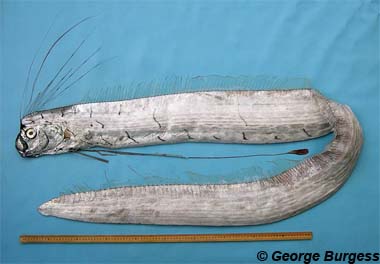
Regalecus glesne
This unusual fish is possibly a source for sea monster legends as its ribbon-like body can grow to 36 feet long in some cases. The long, flat, tapering body is reflective silver with a dorsal fin running the length of it that it uses to swim and turn with. Its abrupt, slightly concave profile is set with a toothless mouth ideal for filtering krill and crustaceans out of the water. It is a deep-water fish that spends time floating vertically in the water column to camouflage itself, trailing the elaborate red first spines of its dorsal fin and pelvic fins.
Order – Lampriformes
Family – Regalecidae
Genus – Regalecus
Species – glesne
Common Names
English language common names are oarfish, giant oarfish, king of herrings, king of the herring, oar-fish, Pacific oarfish, ribbon-fish, ribbonfish, and streamer fish. Other common names are airokala (Finnish), bandfisch (German), brandfisch (German), fjamma tal-fond (Maltese), haringkoning (Dutch), heringskönig (German), kurdele bal??? (Turkish), pai-da-sarda (Portuguese), peixe-real (Portuguese), pez remo (Spanish), pojas (Croatian), re di aringhe (Italian), regaleco (Portuguese), regalengo (Portuguese), rei dels peixos (Catalan), rei-dos-arenques (Portuguese), relangueiro (Portuguese), rey de los arenques (Spanish), reimenfisch (German), roi des harengs (French), régalec (French), sildakongur (Faroese), sildasterril (Faroese), sildekonge (Danish), sillkung (Swedish), sillkungen (Swedish), sneesvis (Afrikaans), síldakóngur (Icelandic), vasilias regon (Greek), and wstegor królewski (Polish).
Importance to Humans
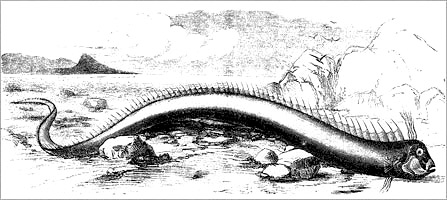
The oarfish is not of commercial value due to its deep water habitat and poor quality of meat which is gelatinous and generally considered inedible. However, considered a gamefish by some, it has been caught with encircling nets and marketed fresh in some local areas. This species is rarely observed by humans when it is swimming at the surface or washed upon the beach. Encounters with live oarfish are very rare. In fact it wasn’t until 2001 that a live oarfish was captured on film by the US Navy.
Danger to Humans
A close relative of the oarfish, the streamer fish (Agrostichthys parkeri) has been reported to be electrogenic, producing a mild shock when handled by humans. It is unclear if the oarfish shares this capability.
Conservation
The IUCN is a global union of states, governmental agencies, and non-governmental organizations in a partnership that assesses the conservation status of species.
> Check the status of the oarfish at the IUCN website.
Geographical Distribution
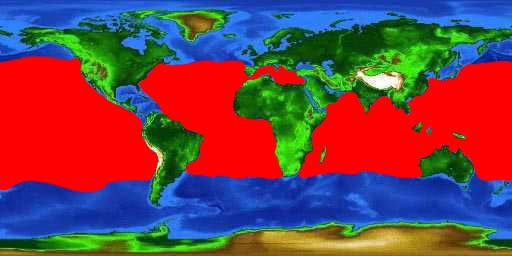
The oarfish is widely distributed in the Atlantic Ocean and the Mediterranean and from Topanga Beach in southern California south to Chile in the eastern Pacific Ocean. These locations are from human observations, however it is thought to be a cosmopolitan species with the exception of the polar seas.
Habitat
An oceanic species, the oarfish is found living at great depths to 3,280 feet (1,000 m) but more typically to depths of 656 feet (200 m). It is occasionally found cast upon beaches after storms or near the surface when injured or dying. This may have led to legendary stories of sea serpent sightings during ancient times by mariners and beach visitors. The oarfish swims by undulating its long dorsal fin while its body remains straight which is knows as an amiiform mode of swimming. It has also been observed swimming in a vertical position in what is believed to be a method that the oarfish searches for prey items. This species is believed to live solitary lives with the exception of spawning activities.
Biology

Distinctive Features
Oarfish have a long tapering body with a small protrusible mouth containing no visible teeth. The body is scaleless with the skin covered instead by silvery guanine. This species has no swim bladder. The dorsal fin originates just above the relatively small eyes, running the entire length of the fish. It is distinctly colored, ranging from pinkish to cardinal red. Consisting of approximately 400 dorsal fin rays, the first 10-12 are elongated forming a trailing crest with reddish spots and flaps of skin on the tip of each ray. The pelvic fins are also elongated and adorned while the pectoral fins are small and located low on the body. There is no anal fin and the caudal fin is either quite small or absent with the body tapering to a fine point.
Coloration
The scaleless body is covered with silver to silvery-blue skin with blotches and wavy markings on the body. Markings fade quickly upon death of the fish. The fins are pinkish or red in color.
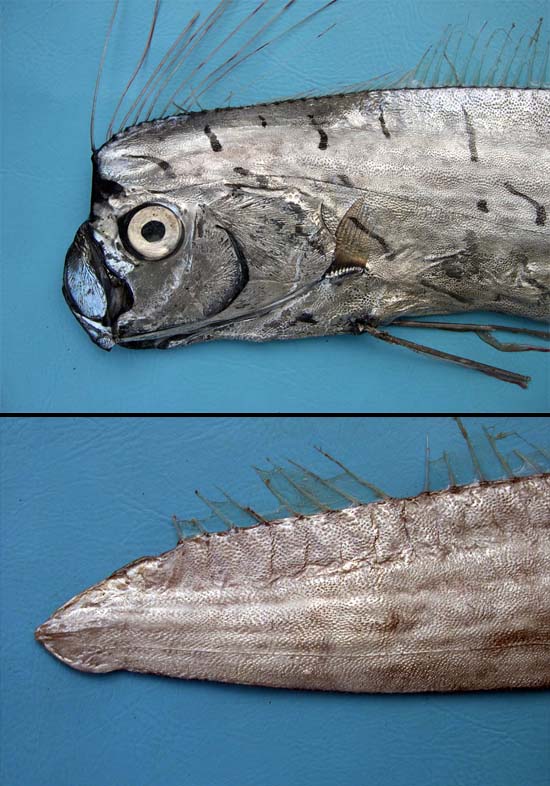
Dentition
Oarfish have no visible teeth.
Size, Age, and Growth
The maximum reported length of the oarfish is 36 feet (1,100 cm) total length although it is more commonly observed at lengths of approximately 10 feet (300 cm) total length. It is considered the longest bony fish alive in modern times by the Guinness Book of World Records. The maximum published weight of this species is 600 pounds (272.0 kg).
Food Habits
Oarfish feed on plankton, crustaceans, and squid by straining them from the water column using specially evolved gill rakes located in the mouth. One specimen caught off the coast of California contained a large volume (10,000 individuals) of krill (euphausids).
Reproduction
Although little is known about oarfish reproduction, spawning has been observed off of Mexico between July and December. The eggs are large, measuring .08-.16 inches (2-4 mm) in diameter and containing numerous oil droplets. After spawning is complete, the fertilized eggs are pelagic, remaining at the surface of the ocean until hatching. It is believed that the eggs take up to three weeks to incubate. Upon hatching, the larvae appear similar to adults but in miniature and feed primarily on plankton until they mature.
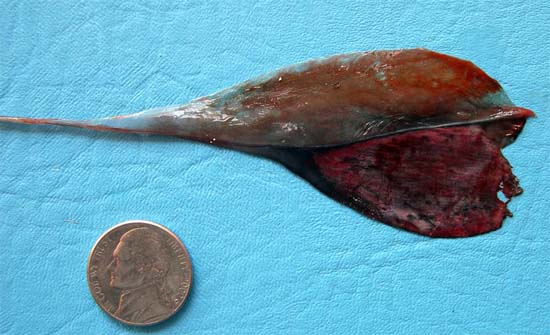
Predators
Due to its significant size, larger fish including sharks are the primary potential predators of the oarfish.
Taxonomy
The oarfish was originally described as Regalecus glesne by Ascanius in 1772. Synonyms referring to this fish in past scientific literature include Regalecus remipes Brünnich 1788, Cepola gladius Walbaum 1792, Gymnetrus hawkenii Bloch 1795, Gymnetrus grillii Lindorth 1798, Gymnetrus ascanii Shaw 1803, Cephalepis octomaculatus Rafinesque 1810, Gymnetrus longiradiatus Risso 1820, Gymnetrus banksii Valenciennes 1835, Regalecus banksii Valenciennes 1835,Gymnetrus telum Valenciennes 1835, Gymnetrus capensis Valenciennes 1835, Gymnetris gladius Valenciennes 1835,Regalecus jonesii Newman 1860, Regalecus pacificus Haast 1878, Regalecus masterii De Vis 1891, and Regalecus caudatus Zugmayer 1914.Oarfish are greatly elongated, large fish in the family Regalecidae. This family, derived from the Latin regalis meaning “royal”, contains four species within two genera. This species, Regalecus glesne, is listed in the Guiness Book of World Records as the longest bony fish alive. Its common name arises from its highly compressed and elongated body or from the old belief that the fish moves through the water by “rowing” itself with the pelvic fins.
Prepared by: Cathleen Bester